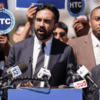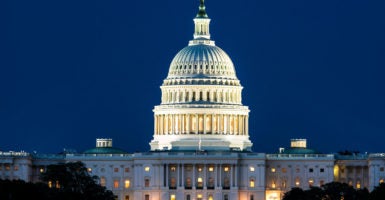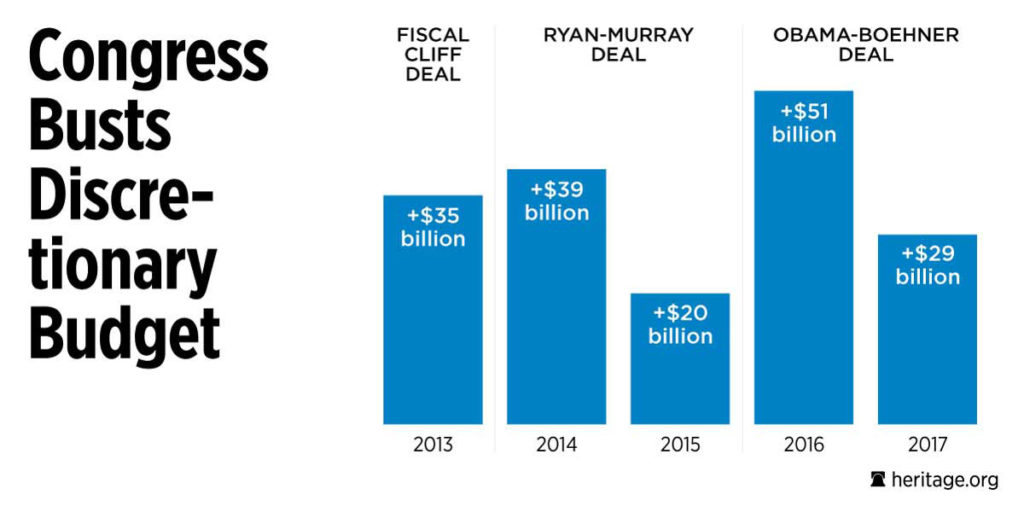It’s an all too familiar sight: It’s the end of the fiscal year, and Congress is scrambling to keep the government open after it has shirked its responsibility to pass the requisite 12 appropriations bills all year.
The end of the fiscal year is when Congress tends to throw fiscal responsibility out the window in order to avoid taking tough votes, especially before an election—and this year is no exception.
In recent Congresses, an end of the fiscal year continuing resolution has become a routine maneuver to push back the spending debate until the holidays in December. That’s when Congress usually scrambles to come to an agreement before the deadline (positioned just as everyone wants to get home to their families), which characteristically takes the form of an immense spending package that blows through the discretionary spending caps Congress set in 2011.
Indeed, since 2013, this breakdown in the budget process has led to Congress busting through its budget caps by a total of $174 billion. That’s billions in spending that would not have happened if Congress had stuck to its normal appropriations process and abided by the caps it instituted under the Budget Control Act of 2011.
So even though Congress promised to return to “regular order” this year by passing all its spending bills before Sept. 30, it’s not surprising to find members in the same position as the past few years. President Barack Obama likewise deserves a great deal of the blame for threatening to veto any appropriations bill that does not bust the caps that he himself signed into law.
Though this year-end breakdown has become routine, Congress is in an even worse position this time around.
Some members have proposed a continuing resolution that would put the funding decisions in the hands of the next Congress, but the more likely result will be to punt the debate into the lame-duck period following the results of the election. Purposefully positioning important long-term decisions for this period is especially egregious, as members of Congress face little accountability during a lame-duck session. This has the potential to further undermine the trust that the public has bestowed on Congress.
Moreover, due to the various budget gimmicks employed in last year’s funding bill, just maintaining current spending levels in a clean continuing resolution would end up exceeding the amended fiscal year 2017 budget cap by $10 billion.
As Heritage Foundation scholar Paul Winfree commented, that means Congress has effectively set itself up for failure. By teeing up spending levels that exceed the already increased budget caps, lawmakers must either utilize more spending gimmicks—flying in the face of fiscal responsibility—or face a politically harsh across-the-board cut in spending. Given the choice between the two, it is probable that members will take the politically expedient route and simply elect to spend more.
Worst of all, by caving to higher spending levels for 2017, breaking the budget caps again in fiscal year 2018—which are set to $16 billion below current levels—almost becomes a foregone conclusion for the big spenders in Congress.
This sets up the next Congress to go back on its promise to rein in spending once again, erasing the one modicum of fiscal restraint imposed on spending during the Obama administration. Continuing this vicious cycle would squander the opportunity to return to normal order during the next presidency and Congress.
Is this the only way forward? Not at all. Congress has options to maintain integrity in the budget process. It should:
- Avoid considering any funding bills during the lame-duck session. If Congress is unable to agree on funding measures for fiscal year 2017 prior to the election, a partial year appropriation to move the decision to the 115th Congress is the best option.
- Cut programs, eliminate corporate welfare, and pursue policy riders to reduce nondefense discretionary spending and improve upon current policy. Heritage’s 110 recommendations for discretionary spending reforms are a good place to start.
- Consider a continuing resolution that reduces nondefense discretionary spending across the board.
After years of shirking the budget process and disregarding its self-imposed fiscal controls, Congress has the opportunity to break the cycle. It should seize it instead of positioning the next Congress yet again to spend more than is necessary to fulfill the federal government’s essential responsibilities.
































